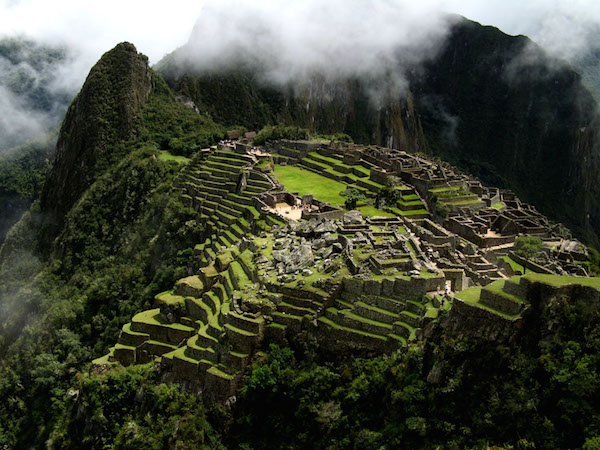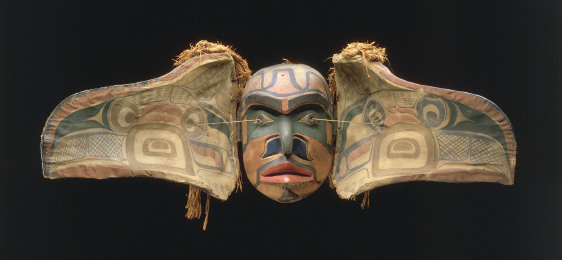<< Hide Menu
Laurie Accede
Laurie Accede
Chavín de Huántar

Image Courtesy of Smart History
Form:
-
The architectural complexes were made from stone.
-
The sculptures and Lazón Stela were made from granite.
-
The jewelry was made from hammered gold. Function:
-
Chavín de Huántar was the religious capital of the Chavín people, and it had a temple people used for worship. It was also a pilgrimage site.
-
The Lazón (means blade in Spanish) Stone was symbolic of a diety
-
The relief sculptures were primarily decorative
-
The nose ornament was probably worn during religious ceremonies to allowed the wearer to undergo a spiritual transformation Content:
-
The temple interior is filled with sacred maze-like tunnels and chambers. It consists of two sections: the Old and New Temple
-
The inner-most chamber of the temple held the Lazón Stela which displayed a composite human-animal figure with jaguar characteristics
-
The relief sculpture also featured similar animal motifs (symbols), primarily of jaguars and snakes
-
The nose ornament had snake heads on both ends Context:
-
The Chavín civilization occupied in coastal Peru from 1200-500 BCE.
-
This civilization was named after its main architectural site, Chavín de Huántar
-
Most of the artwork is symmetrical and features composite figures
Mesa Verde Cliff Dwellings

Image Courtesy of Khan Academy
Form:
-
Sandstone Function:
-
This structure housed families. It had living quarters, ceremonial rooms, and a farming area. Content:
-
The structure was divided into multiple housing units.
-
Contains kivas, which were pits in that ground that people gathered around to interact or conduct rituals Context:
-
The Mesa Verde Cliff dwellings inhabited the Ancient Puebloans, who were also known as the Anasazi, which means the “ancient ones.”
Yaxchilán

Image Courtesy of Wikipedia

Image Courtesy of Khan Academy
-
The architectural complex was made from limestone Function:
-
This was a temple complex that also contained a main plaza that was surrounded by other buildings Content:
-
Both Structure 33 and Structure 40 had arched interiors and contained decorative reliefs sculptures
-
Lintel 25 was placed above a doorway and depicted a narrative- Lady Xook (Mayan Queen) manifesting a serpent to have a spiritual vision- Lady Xook is also holding bloodletting materials as she prepares for a ritual Context:
-
The Mayans occupied the Yucatán peninsula from 1200-1500 CE
-
Structure 23 is dedicated to Lady Xook
-
Bloodletting was central to Mayan life, and the blood rituals were common for members of the royal family
Great Serpent Mound

Image Courtesy of The College Board
Form:
-
Earthwork Function:
-
The intent is unclear, but it is possible that the site was used for astrological purposes Content:
-
An effigy mound (a mound in the shape of an animal) that represents a snake Context:
-
These mounds were very popular in Mississippian culture
Templo Mayor

Image Courtesy of Worldh History Encyclopedia
-
The temple was made from stone.
-
The Coyolxauhqui Stone was made from volcanic stone
-
The Olmec-style mask was made form jadeite
-
The Calendar Stone was made from basalt Function:
-
Each temple was dedicated to a deity
-
The relief sculptures display narratives and were decorative
-
The calendar was also used to coordinate rituals with the Aztecan calendar Content
-
Stepped pyramids, which used stacked platforms to build the pyramid shape (this contrasts the flat, smooth-surfaced Egyptian pyramids).
-
The Coyolxauhqui Stone is depicting an Aztec mythological event- Coyolxauhqui, the moon goddess, is plotting the death of her mother, Coatlicue, a "mother-earth" goddesss in Aztecan culture- When Coatlicue is killed, Huitzilopochtli, the brother of Coyolxauhqui, emerges and kills Coyolxauhqui, who falls down the shrine
-
The Calendar stone reflects the cycle of time (which is important in Aztec culture) and depicts motif traditional to Aztecan cosmology
-
The Olmec-style mask has frowning facial features Context:
-
The Aztecs were also known as the Mexica, and they inhabited Mexico from 1375-1520 CE
-
They followed a polytheistic religion
-
The temple was believed to be the center of the Aztec's universe, which is known as axis mundi
-
One temple was dedicated to Tlaloc, the god of rain and agriculture. The other was dedicated to Huitzilopochtli, the god of war, fire, and the sun.
-
The story of Coyolxauhqui is representative of how the Aztecs threw the bodies of sacrificed people down the temples
-
The Olmec masks primarily demonstrates how the Aztecs developed a system of trade with other civilizations, and they also embraced artwork from previous cultures
-
The temples were destroyed by the Spanish in 1520, who viewed Aztecan traditions as barbaric
Ruler’s Feather Headdress

Image Courtesy of Daily Art Magazine
-
Contains gold and feathers from quetzal and cotinga birds Function:
-
This headdress was worn by Motecuhzoma II during ceremonies Content:
-
Multiple long, green feathers (about 400) attached together Context:
-
400 feathers symbolizes eternity
City of Cusco, including Qorikancha, Santo Domingo, and Walls at Saqsa Waman

Image Courtesy of Smart History
-
Andesite Function:
-
Qorikancha was the city's main temple, it was originally used by priests to as an observatory (used to observe the night sky)
-
The City of Cuzco was the capital of the Inca Empire Content:
-
The plan of the City of Cuzco was in the shape of the puma, which was a royal animal in Incan culture- The walls at Saqsa Waman were located at the "head" of the puma-shaped city
-
The temple used special stone masonry and the interior was once decorated in gold- This was to represent sunshine as the temple originally honored the sun Context:
-
The Incans were masters of masonry
Maize Cobs

Image Courtesy of Khan Academy
Form:
-
Metal alloys Function:
-
This may have been a part of a "garden" of corn, and was possibly used as a good luck charm to ensure a successful harvest Content:
-
Life-size replication of corn
-
Uses the repoussé technique which is when a piece of metal is hammered to create texture Context:
-
Maize (corn) was a stable crop of the Incans in the Andes mountains
City of Machu Picchu

Image Courtesy of Khan Academy
-
Granite Function:
-
The structure was used by members of the ruling class
-
The observatory was used to chart the sun movements especially during the solstices
-
The Intihuatana Stone aligns with the sun and was used for ceremonies Content:
-
Ashlar masonry consisting of many carved pieces of stone grooved together to fit the terraces in the cliffs Context:
-
Maccu Picchu include numerous other buildings. It was located in the central highlands of Peru, during the Incan Empire from 1450-1540 CE
All-T’oqapu Tunic

Image Courtesy of Smart History
Form:
-
Camelid fiber and cotton Function:
-
These were garments worn by individuals to demonstrate their status and accomplishments in society Content:
-
Contains t'oqapu, which are are squares that decorate the garment. Each square symbolizes a particular person, event, or place.
-
There are small slits in the fabric that are cut for the person's arms Context:
-
Acllas were the women who were chosen to weave textiles and fabrics, such as this tunic
-
This piece demonstrates the Incan use of abstract designs and motifs
Bandolier Bag

Image Courtesy of Khan Academy
Form:
-
Beadwork on leather Function:
-
This was a status symbol worn by both men and women Content:
-
A colorful beaded pouch with floral designs Context:
-
This bag comes from the Lenape Tripe who inhabited Eastern Delaware in the US
-
The bags were made by women, and were typically worn across the shoulders
-
The various materials used to make the bag, such as glass beads and silk ribbons from Europe, indicate the various trade networks that were present
Transformation Mask

Image Courtesy of Smart History
-
Wood, paint, and string Function:
-
These masks were part of costumes that were used for dance performances and ceremonies Content:
-
A bird exterior with a human face on the inside Context:
-
This mask comes from the Kwakwaka’wakw people of the northwest coast of Canada
-
The mask wearer would pull the strings to open and close the mask
-
The human faces on the masks would sometimes show the faces of an ancestor; and these masks were also inherited by family members
-
The birds had cultural significance
Painted Elk Hide

Image Courtesy of Khan Academy
-
Painted elk hide Function:
-
This was worn by a warrior to demonstrate their accomplishments and display important battles
-
These were also hung on walls as decoration Content:
-
Various animals were displayed with some being hunted
-
The ritual Sun Dance, that was used to celebrate a hunt and honor the Creator deity is also displayed Context:
-
These elk hides depict the lives of communities living in the Plains located in Wyoming
Black-On-Black Ceramic Vessel

Image Courtesy of Khan Academy
-
Blackware ceramic Function:
-
This was mainly a decorative vessel Content:
-
Various finishes on the vessel: some areas have shine, others are more matte
-
Contains symmetrical abstract elements Context:
-
The vessel was made with a special technique that involved forming coils out of organic materials to form the shape, and then firing the pottery at high-temperatures. The suface was polished to give it the different finishes.

© 2024 Fiveable Inc. All rights reserved.